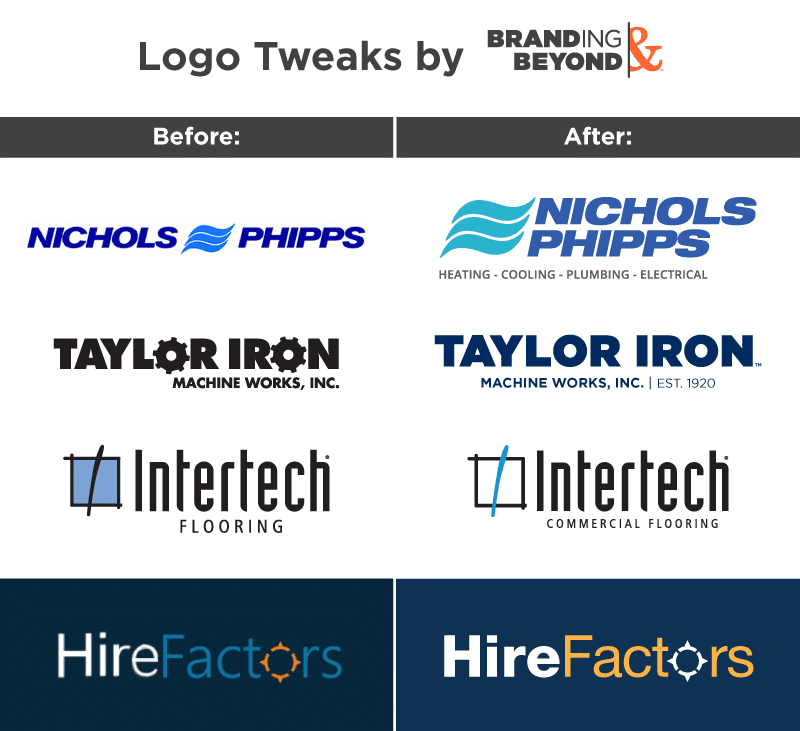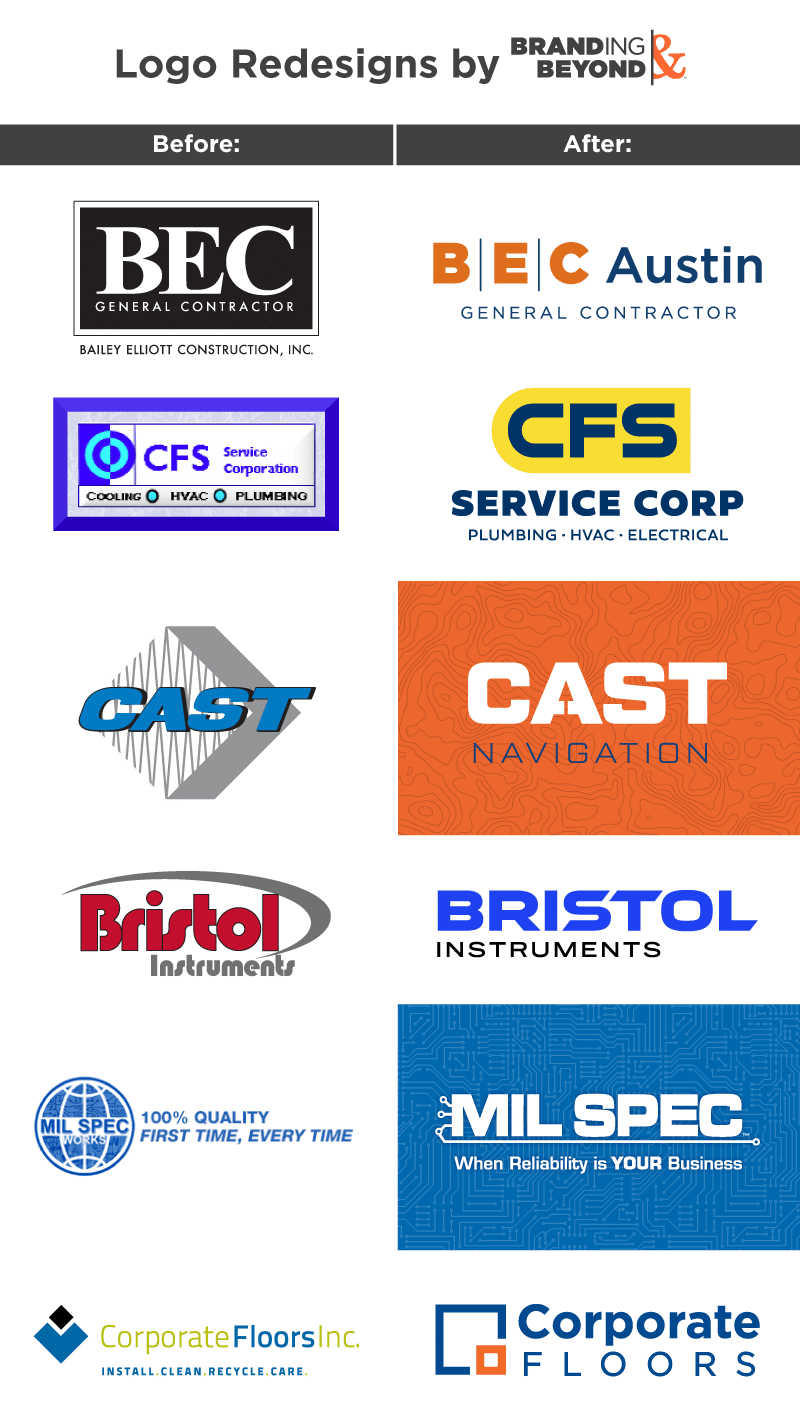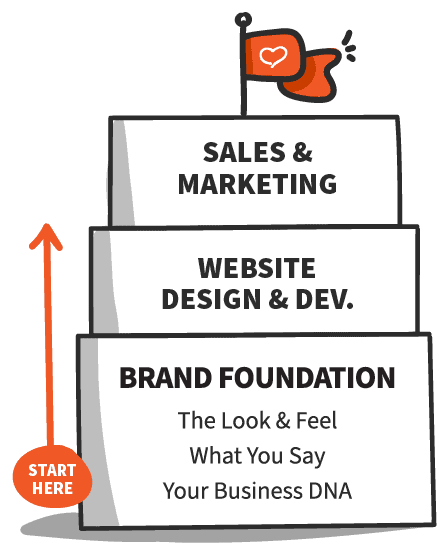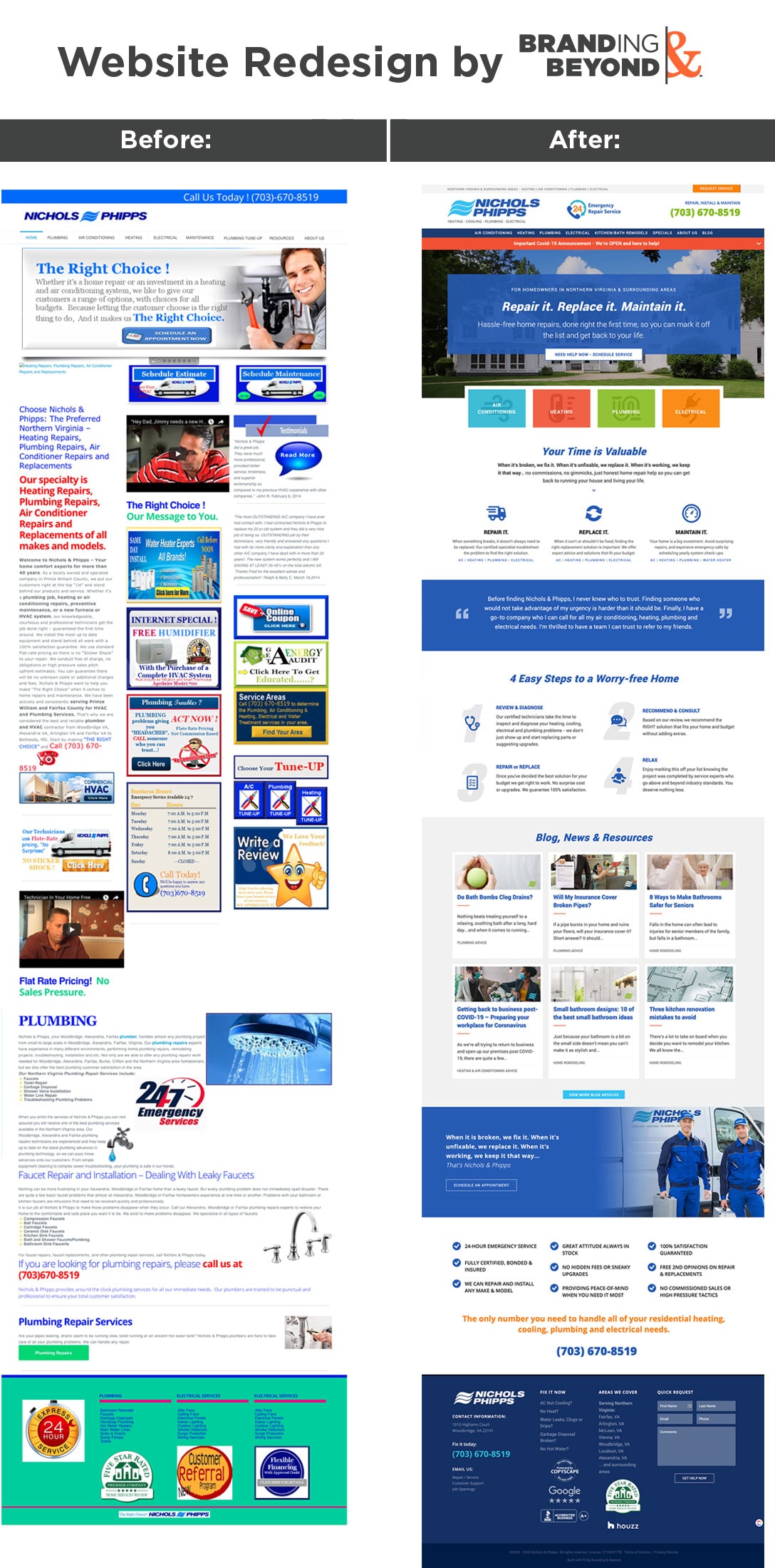
Can Rebranding Save a Business?
Rebranding done for the wrong reason can be an expensive nightmare, a cosmetic exercise that’s equivalent to putting a Band-Aid on your knee when you have a broken leg.
Rebranding is adapting and evolving. Every company will eventually rebrand, sooner or later, and sometimes multiple times over the company’s lifetime. Rebranding is a healthy realignment process. It may not always be a significant shift, but it should always be a refining process.
Rebranding is about taking the time to step back to evaluate the firm, its products, its customers, the market, how it fits in the market, what it stands for, what it looks like, and what it says.
Then decide what needs to change, evolve, and or be revitalized.
Our point of view: Rebranding is not a one-size-fits-all sort of subject. There are brand refreshes, minor rebrands, intensive rebrands, and everything in between. Rebranding is a customized solution based on need and budget.
However, every rebrand we do at Branding and Beyond includes some level of evaluating your company, products, customers, competitive differentiation, messaging, positioning, and visual identity. Many branding firms only do visual rebranding. To us, that is like saying you remodeled your house and all you did was paint the front door.
If your business is failing, or stuck in a rut, could a rebrand save it?
Rebrands (when done right) help you see your business in a whole new light and from different angles. The rebranding process can align your team and help them refocus on whom you’re meant to serve, how you can reach them, and open up new possibilities in the online world.
If you’ve found yourself stuck in a downward spiral, or just lost in the sea of sameness, a rebrand might just be the perfect solution for your business.
But how do you know for sure that a rebrand will help your business, and is the right choice?
Rebranding can be the key to getting your business back on the right track, and it shouldn’t be seen as a sign of weakness. Knowing you need to evolve is a strength, and it shows that you’re ready to make a change to help your business move forward.
From startups to large corporations, rebranding has helped businesses readjust their views, realign their core offerings, and improve their business.
As we said before, a brand is so much more than your logo or the color palette you choose for your website. It’s the experience of interacting with your company. It’s how you’re seen in the world – both online and offline – to prospects, customers, and potential employees.
So how do you know if you need to rebrand?
Here are some of the most common clues that it might be time to rebrand:
- Your firm lacks clarity, consistency, and you don’t look or sound like the badass firm you are
- You have a big anniversary coming up and it is time to clean things up a bit
- You are looking to sell in the next 3 to 5 years and want to increase your brand equity
- Your website is a credibility killer and your sales team is tired of it
- Customers are confused about what you do
- You are confused about how to talk about your business in a way that is jargon-free and meaningful to clients
- You have significantly grown or pivoted since your website was built and it's a poor reflection of who your company is today
- New prospects act as if you are interchangeable with your competitors, leaving you to compete solely on price
- You keep attracting non-ideal clients
- You want to restyle your business. New messaging, new marketing ideas, all aligned with what your ideal clients actually care about
- You are merging, acquiring, moving offices, adding new services, or branching into a new target market
As you can, there are many reasons to do some level of revitalization of your brand. A good branding firm can help you figure out what will help your company's unique issues.
Branding is incredibly important in the online world. With so many people fighting for the top spot in a prospect’s mind, it can be difficult to stand out without a solid brand foundation and strategy supporting your efforts.
If you haven’t intentionally built and managed your brand, it can be a rocky road to the top of the pile. And let’s be real, you probably won’t reach the top without a clear, cohesive, and consistent brand.
You might have started out with a well-defined brand, but over time lost your way and didn’t keep it aligned with your business as it evolved. That’s okay, it happens. The important thing is to notice when it’s happening – and fix it.
Rebranding allows you to refine what you are known for in a way that aligns with who you really are as a firm and is meaningful to the audience you want to work with.
Is rebranding a good idea, and will it save my business?
Rebranding alone won’t be able to save your business if it is already in a ditch, you have bigger problems than branding. You can’t just slap some new messaging and a new visual identity on your company and hope for the best. I mean, you could, but it won't get the results you want.
Rebranding is not about fabricating a fantasy image of what you wished your firm was like. That is not authentic, and your prospects' highly-tuned BS meters would bust you in no time at all. You can undoubtedly be aspirational in your messaging and project an image that is slightly ahead of where you are today, but you better strive and reach for that aspiration, or customers will call you out on the overhype.
Also, ‘save’ is a loaded word. Let me put it this way, if you do damned good work, have a reliable team, and have repeat business – but you’ve lost your way when it comes to marketing your business, being meaningfully different, standing out in your market, or just feeling/looking outdated, rebranding will help a lot.
A good rebrand is about finding who you are, defining it, designing it, and then applying the visual and verbal personality to everything.
Don’t get me wrong, your business doesn’t need to be perfect on the inside first. Most companies are a bit messy because humans are involved. But you do need to have repeat and referral customers, which are both a sign that there is something actually TO brand.
You and your team have to be ready to dig in, be prepared for change, and ready to reenergize your company for a rebrand to work. Otherwise, it’s just a complete waste of time (and money). If working with my team, I will tell you ‘no' if its obvious that you aren't ready or rebranding isn't appropriate at this time.
How to rebrand a business
Rebranding isn’t always a nice, relaxing walk in the park. In a lot of ways, its an act of sacrifice. Everyone is not your customer. The sooner you come to terms with that and embrace it, the happier and more focused you will be.
Here’s a very high-level intro to the 6 steps you’ll need to take to rebrand your business successfully:
1. Identify the problem and why a rebrand is necessary.
Before you start pulling things apart and attempting to piece together a new brand – take a deep breath and look at where you are now. Create a detailed analysis of your current brand so you can assess the problem areas. A SWOT chart is particularly helpful at this stage to do a high-level mapping of your strengths, weaknesses, opportunities, and threats. Here is a SWOT analysis template I set up for you to use or just draw a big + on the white board and jump in.Invite your sales team to this meeting, not just the veeps and the C suite… seriously.
By figuring out what is working and what isn’t, you’ll be able to map out a strategy and avoid the trap of tactical busywork.
For example, you might figure out that you were targeting the wrong audience for the services you provide. You might attract the wrong kind of staff. You might be stuck competing solely on price. You don’t have the processes and infrastructure to support the new business you want to attract. There is a disruptive threat that is bigger and closer than you thought.
Once you’ve identified what’s working and what is not, you can move forward to create something stronger and hopefully more resilient.
2. Set clear and attainable goals.
With full knowledge of the strengths and mistakes you’ve made in the past and access to in-depth, accurate market research, you can push forward and set clear and attainable goals for yourself and your business.
By setting realistic goals you want to achieve and how they will be measured, you’ll be able to focus and know if the rebrand has been a success.
- Business goals
- Awareness goals
- Efficiency goals
3. Do your market research.
If you want to build a strong brand for your business, then market research is a necessity. Without it, you’ll just be guessing/using your own judgment, which is like walking a tightrope blindfolded. No matter how good your balance is, the chances of falling are pretty high.
Here are some ideas on what to research:
- Gather everything you use to market your business and evaluate it honestly.
- Interview the sales team, they are the boots on the ground – what’s going on, what do they need, and what are clients really buying.
- Where are the sticking points in the sales cycle and what can be done to shorten the sales cycle?
- Interview repeat customers and find out why they keep coming back, the answers might surprise you!
- Are you working with the right segment of your customers?
- Talk to employees at all levels, what is the true culture of the business? What are the core values? Is there a hiring process beyond a skills match?
- Research your competitors, how are they talking about what they do? Are they differentiated or positioned in the market?
- Evaluate your firm’s authority in the market.
- How is the website performing? What could it do that it hasn’t been tasked with, and how is it doing technically under the hood?
- Evaluate your digital footprint on the internet: is it consistent, clear, and credible?
- By getting as much internal and external insight as possible, hopefully, you will be able to see the through-line that will be the basis of your rebrand.
By studying the market, you’ll be able to identify who your real competitors are, what they’re doing, how they’ve gotten to where they are in the industry, and how you can outperform them in a meaningful way.
4. Define your verbal and visual brand personality.
You’ve done the research and defined the goals now it’s time to lay it all out and look for patterns, and connect the dots. Now it is time to craft your brand personality.
A Brand Personality is the visual and verbal identity that represents your company. This identity is applied to and rides along with, your website and all of your marketing and advertising (this application IS branding).
- Differentiation – are you relevant and meaningfully different in a way your audience cares about?
- Positioning – the space you want to occupy in the mind of your audience as compared to the alternative
- Messaging – value proposition, promise, short/long description, slogans, taglines, tone, voice, etc.
- Visual identity – colors, patterns, shapes, texture, logo, design, etc.
- Audible identity – if you do videos or commercials, actual sounds may be part of your personality
All of this is based on the research of who you are, who you serve, what value you create, the market you are in, how you are different, what you sound like and what you look like.
5. Apply it to everything.
Now that you have a defined personality that fits your company, you need to apply it to everything you do.
Don’t panic, you don’t have to do all of this at once, you can have a phased roll-out of the new branding. But I have to say that once you start to apply your new brand, you'll want to do it everywhere. It’s like having a personal stylist overhaul your wardrobe and everything in your closet looks and fits amazing. You feel like a million bucks and you don’t want to go back.
Here is a shortlist of assets/things you'll want to include in your rebranding roll-out:
- Website and landing pages
- Advertising campaigns and funnels
- Slide decks
- All marketing materials
- Proposals and stationery
- Social media
- Team apparel
- Vehicle wraps
- Signage
- Tradeshow banners and booth design
- Onboarding kits for clients and employees
6. Launch and promote.
Your current clients and staff might be a bit confused if your brand changes suddenly with no warning. It’s important to carefully explain and promote your new brand internally before making the change. Get the team involved early so this is being done with them and not to them.
If your rebrand is more about refining and not overhauling, you don't necessarily need a big roll-out.
Depending on the business and the type of rebrand, you may want to promote your business as soon as the launch of your new brand has happened, so be sure to take the time to organize a detailed marketing and promotion strategy.
So, that's your bird’s eye view of what a rebrand entails. There are hours, days, weeks, and months of hard work that goes into a successful rebrand.
What happens to your logo when you rebrand? Are you worried? Don't be!
The company logo is often be a bit of a sacred cow in a firm. I totally get it. And trust me, we are completely empathetic to not only the history and recognition of the logo but also to the financial footprint of changing the logo.
Your logo is a key brand asset and an identifier of your company, changing it can be scary. It’s also scary to work with an outdated logo when you are trying to modernize a brand. Even when a logo redesign is off the table, we often request to tweak the logo a bit to make it more professional looking and easier to work with.
To set your mind at ease, here are some examples of logo tweaks that didn’t change the original too much but definitely improved its usability and feel.
And before you say it, YES I get that showing logo redesigns when I say over and over, “Your brand is not your logo”, feels a bit hypocritical. But it's the easiest way to set logo worries aside and show you that subtle changes can make a big difference.

In contrast, here are a few before and after examples of full logo redesigns.
A few of these companies were ready for a logo redesign and some were not, but after I showed them the possibilities they were all ready to say goodbye and move on.

 Here at Branding & Beyond, we'll help you define your brand personality and build out a solid foundation that will make sales easier and marketing more effective. We don't fabricate brands. We find what already exists within your company, and craft it into a verbal and visual identity that we can apply to everything internally and externally.
Here at Branding & Beyond, we'll help you define your brand personality and build out a solid foundation that will make sales easier and marketing more effective. We don't fabricate brands. We find what already exists within your company, and craft it into a verbal and visual identity that we can apply to everything internally and externally.
When you work with us, we guide you through the brand alignment process. This isn’t our first rodeo.
We’ll help you build a solid brand foundation to implement a marketing plan that actually delivers.
Build your brand foundation today.
The ‘After the Blog Show’
And just for funsies, here is the website before and after for Nichols & Phipps
This is an extreme example of a company website that did not reflect the quality of work they do. Nichols & Phipps does really great work and has a lot of repeat and referral business. But you couldn't tell that from the outside.
These look like two completely different companies. We didn't change the company. We just matched their branding with who they really are by finding and defining their brand personality and creating a marketing strategy for the type of customer they wanted to attract. And boy oh boy has it worked.

Tracy O’Shaughnessy Founder / Lead Brand Strategist of Branding & Beyond
Tracy and her team help firms in and around the B2B building trades look and sound credible online and off.
She has been in the industry since the early '90s and is tired of seeing fantastic firms struggle, blend in, and get bypassed by prospects who judge them solely on the outdated information found online.
Branding & Beyond's mission is to solve real business problems and build the brand foundation clients need to get noticed and hired.
You can find Tracy on Linkedin and here on this blog.
